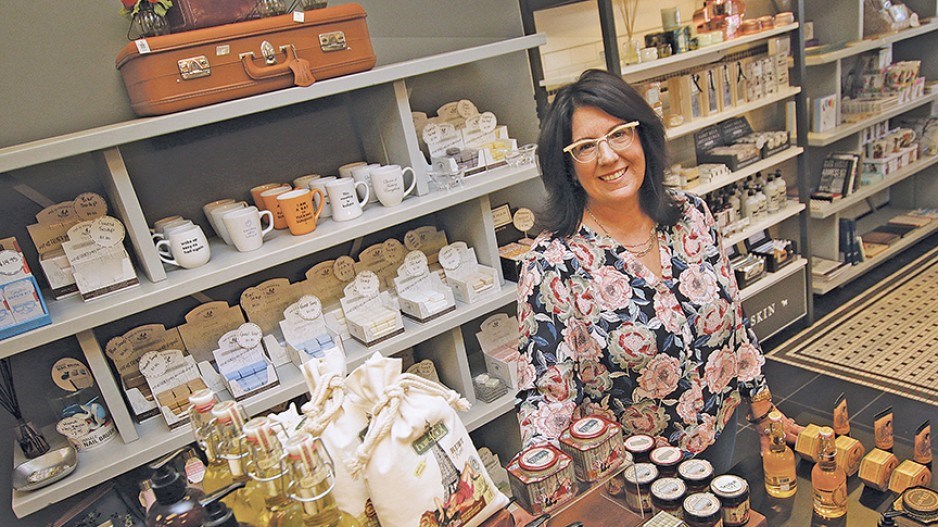When LaLa’s owner Kristina Egyed closed her two jewelry, accessories and homeware stores to help limit the spread of the COVID-19 virus, she focused on upgrading technology so her stores could have at least a trickle of sales.
Back in 2011, she created her store’s first e-commerce website, using U.S.-based BigCommerce’s technology, but she found the site clunky and shut it down years ago. With Ottawa-based Shopify (TSX:SHOP) rapidly growing, planning to hire up to 1,000 workers in Vancouver and on the verge of passing the Royal Bank of Canada (TSX:RY) as the most valuable company on the Toronto Stock Exchange, Egyed said she thought she’d give its technology a try to power e-commerce sales.
Shopify software also helps retailers with point-of-sale transactions and inventory control, as does Montreal’s Lightspeed POS Inc. (TSX:LSPD), but Egyed said she was content to continue using Maple Ridge’s Pacific Amber Technologies Inc. for those needs.
The key technology upgrade that she knew she needed to make was to again sell online.
Retail analysts, such as DIG360 owner David Gray, have been predicting that e-commerce sales will surge as a result of people cultivating online habits while being stuck at home during the pandemic.
It took Egyed nine days to get her e-commerce website up and running, and she received her first sale on April 18, the first day that her e-commerce was functional.
The process for business owners is to create an account with Shopify, and then use the company’s online software-as-a-service platform to devise what template theme and style they want their store’s website to have.
When Egyed did this, Shopify auto-populated her LaLas.ca domain with the template and the words and colours that she chose.
A person she had hired to do IT work provided assistance, and she said that entrepreneurs could hire a third-party Shopify expert to help with the initial set-up.
Shopify then charges her a $29 monthly fee, plus a commission on sales and a transaction fee.
Fees vary by customer, depending on a wide variety of factors.
Egyed was also able to start using Shopify at a time when it had a promotion where the first three months were free.
She admitted that creating a website with Shopify technology has been a challenge.
“Don’t feel that this is a breeze, and anybody can pick this up,” she said. “Its a hard thing to do. Had I not been as well versed as I was in how to put together a website, because of doing it in 2011, this process would have taken me a lot longer. It’s still a huge learning curve. I don’t want to underestimate that learning curve. But once you’ve got it you’ve got it.”
She recently reopened her Commercial Drive store part-time, and the store generates about 6% of the revenue that she collected pre-pandemic. Her e-commerce website contributes about 2% of her pre-pandemic sales.
Gray noted that traditionally, “there has been a big divide between what independent retail could afford for e-commerce, compared with the big chains.”
Large chains long ago used pricy systems that linked into global enterprise systems run by behemoths such as Germany’s SAP Inc. (NYSE:SAP), he explained.
“The brilliance of Shopify is that it really closed that gap in a hurry. Now, anybody can get [an e-commerce website with] capability and functionality.”
As Shopify grew, it expanded its offerings to large and small ventures.
The B.C. government, for example, contracted Shopify to run e-commerce for its BC Cannabis Stores. The British Columbia Liquor Distribution Branch told Business in Vancouver in an email that Shopify’s service was “consistent,” but would not elaborate.
Alphabet Inc.’s (Nasdaq:GOOG) Google Canada Managing Director for Retail, Eric Morris, told BIV that regardless of whether a retailer has e-commerce, it should make sure that it has clear online communication about when it will reopen and what its hours are.
His company’s Google My Business program enables businesses and to create large deck cards that appear to the right of search results. The cards contain photos, the address, hours of operation and other information – all at no cost to the retailer.
Morris said it is then up to the owner to update information. He added that the feature is separate from advertising that Google sells and tends to be charged on a pay-by-click basis. •




